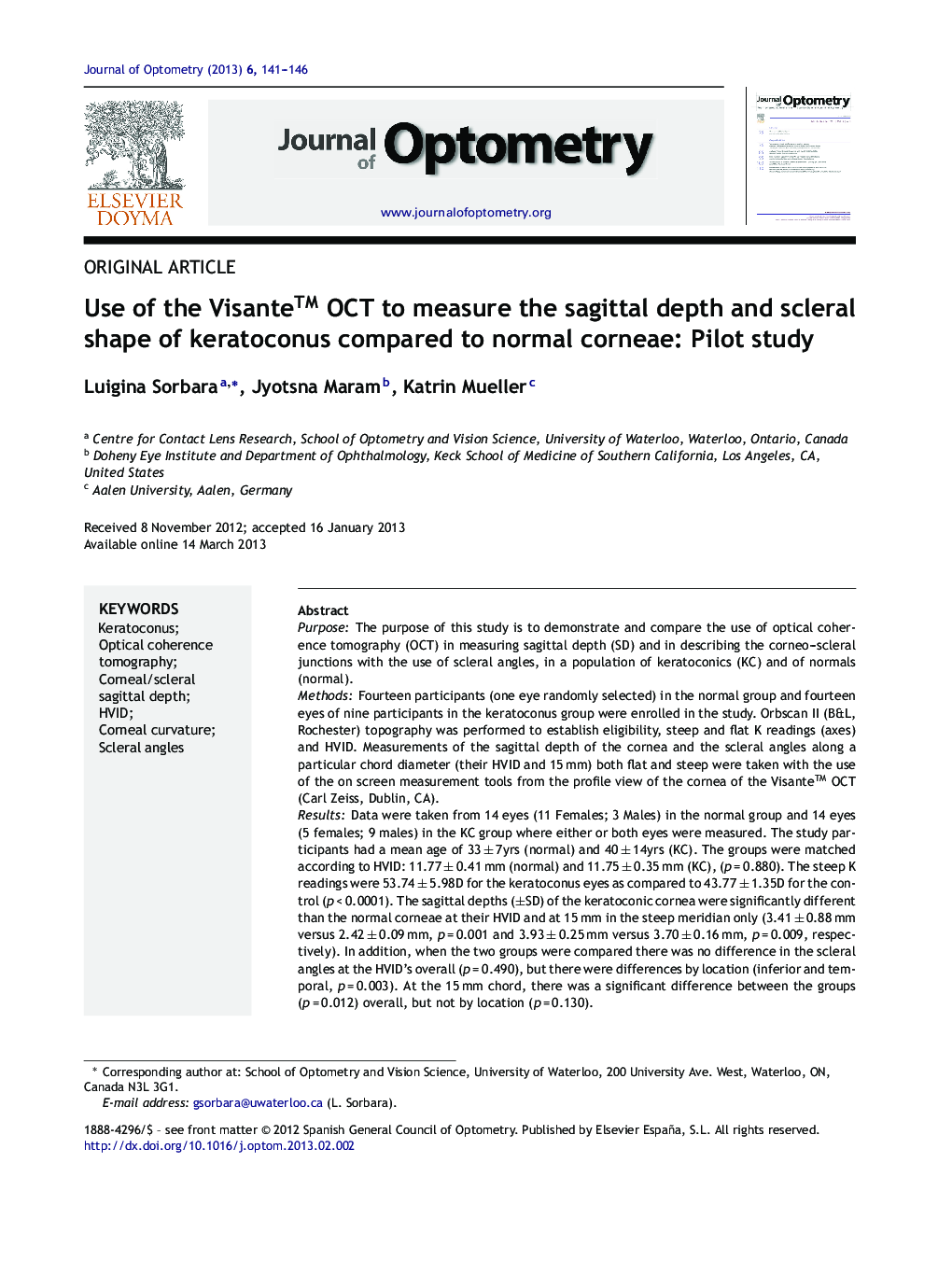| کد مقاله | کد نشریه | سال انتشار | مقاله انگلیسی | نسخه تمام متن |
|---|---|---|---|---|
| 2700836 | 1144374 | 2013 | 6 صفحه PDF | دانلود رایگان |

PurposeThe purpose of this study is to demonstrate and compare the use of optical coherence tomography (OCT) in measuring sagittal depth (SD) and in describing the corneo–scleral junctions with the use of scleral angles, in a population of keratoconics (KC) and of normals (normal).MethodsFourteen participants (one eye randomly selected) in the normal group and fourteen eyes of nine participants in the keratoconus group were enrolled in the study. Orbscan II (B&L, Rochester) topography was performed to establish eligibility, steep and flat K readings (axes) and HVID. Measurements of the sagittal depth of the cornea and the scleral angles along a particular chord diameter (their HVID and 15 mm) both flat and steep were taken with the use of the on screen measurement tools from the profile view of the cornea of the Visante™ OCT (Carl Zeiss, Dublin, CA).ResultsData were taken from 14 eyes (11 Females; 3 Males) in the normal group and 14 eyes (5 females; 9 males) in the KC group where either or both eyes were measured. The study participants had a mean age of 33 ± 7yrs (normal) and 40 ± 14yrs (KC). The groups were matched according to HVID: 11.77 ± 0.41 mm (normal) and 11.75 ± 0.35 mm (KC), (p = 0.880). The steep K readings were 53.74 ± 5.98D for the keratoconus eyes as compared to 43.77 ± 1.35D for the control (p < 0.0001). The sagittal depths (±SD) of the keratoconic cornea were significantly different than the normal corneae at their HVID and at 15 mm in the steep meridian only (3.41 ± 0.88 mm versus 2.42 ± 0.09 mm, p = 0.001 and 3.93 ± 0.25 mm versus 3.70 ± 0.16 mm, p = 0.009, respectively). In addition, when the two groups were compared there was no difference in the scleral angles at the HVID's overall (p = 0.490), but there were differences by location (inferior and temporal, p = 0.003). At the 15 mm chord, there was a significant difference between the groups (p = 0.012) overall, but not by location (p = 0.130).ConclusionsMeasurement of the sagittal depth and the corneal-scleral junction angle in the steepest meridian at either the HVID or at 15 mm are two metrics that significantly differentiate normals from keratoconics.
ResumenObjetivoEl objetivo de este estudio fue el de demostrar y comparar el uso de la tomografía de coherencia óptica (OCT) para medir la profundidad sagital, y describir las uniones córneo-esclerales con el uso de ángulos esclerales, en una población de pacientes normales y con queratocono.MétodosSe incluyó en el estudio a catorce participantes (eligiendo un ojo al azar) en el grupo normal, y a catorce ojos de nueve participantes en el grupo de queratocono. Se realizó una topografía Orbscan II (B&L, Rochester) para establecer la elegibilidad, las lecturas (ejes) K flat (plana), K steep (inclinada), y el HVID (diámetro del iris visible horizontal). Se midieron la profundidad sagital de la córnea y los ángulos esclerales, así como un diámetro particular de la cuerda (HVID y 15 mm), tanto plano como inclinado, utilizando las herramientas de medición en pantalla desde la visión de perfil de la córnea del Visante™ OCT (Carl Zeiss, Dublin, CA).ResultadosSe obtuvieron datos de 14 ojos (11 mujeres; 3 varones) en el grupo normal, y de 14 ojos (5 mujeres; 9 varores) en el grupo de queratoconos, midiéndose un ojo o ambos. La edad media de los participantes en el estudio fue de 33 ± 7 años (grupo normal) y 40 ± 14 años (queratocono). Los grupos se emparejaron conforme al HVID: 11,77 ± 0,41 mm (normal) y 11,75 ± 0,35 mm (queratocono), (p = 0,880). Las lecturas K del meridiano más curvo fueron 53,74 ± 5,98D para los ojos con queratocono, en comparación a 43,77 ± 1,35D para el grupo de control (p < 0,0001). Las profundidades sagitales (±SD) de las córneas con queratocono fueron considerablemente diferentes a las de las córneas normales tanto en el HVID como a 15 mm, únicamente en el meridiano más curvo (3,41 ± 0,88 mm frente a 2,42 ± 0,09 mm, p = 0,001 y 3,93 ± 0,25 mm frente a 3,70 ± 0,16 mm, p = 0,009, respectivamente). También, al comparar los dos grupos, no existió diferencia en los ángulos esclerales con un HVID global (p = 0,490), aunque existieron diferencias según la localización (inferior y temporal, p = 0,003). Con una cuerda de 15 mm, se produjo una diferencia significativa entre los grupos (p = 0,012) globalmente, aunque no según la localización (p = 0,130).ConclusionesLa medición de la profundidad sagital y del ángulo de unión corno/escleral en el meridiano más curvo, tanto para el HVID como para 15 mm, son dos valores que diferencian considerablemente a las córneas normales y a aquellas con queratocono.
Journal: Journal of Optometry - Volume 6, Issue 3, July–September 2013, Pages 141–146